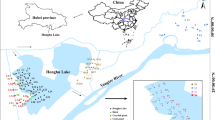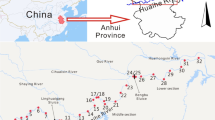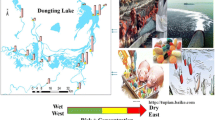Abstract
This study aimed to quantify the environmental fate of antimicrobials applied in Fenneropenaeus chinensis aquaculture production in China and to assess their potential risks for surrounding aquatic ecosystems, for the promotion of antimicrobial resistance in target and non-target bacteria and for consumers eating shrimp products that contain antimicrobial residues. For this, we first used the results of an environmental monitoring study performed with the antimicrobial sulfamethazine to parameterize and calibrate the ERA-AQUA model, a mass balance model suited to perform risk assessments of veterinary medicines applied in aquaculture ponds. Next, a scenario representing F. chinensis production in China was built and used to perform risk assessments for 21 antimicrobials which are regulated for aquaculture in China. Results of the model calibration showed a good correspondence between the predicted and the measured sulfamethazine concentrations, with differences within an order of magnitude. Results of the ecological risk assessment showed that four antimicrobials (levofloxacin, sarafloxacin, ampicillin, sulfadiazine) are expected to have adverse effects on primary producers, while no short-term risks were predicted for invertebrates and fish exposed to farm wastewater effluents containing antimicrobial residues. Half of the evaluated antimicrobials showed potential to contribute to antimicrobial resistance in bacteria exposed to pond water and farm effluents. A withdrawal period of three weeks is recommended for antimicrobials applied via oral administration to F. chinensis in order to comply with the current national and international toxicological food safety standards. The results of this study indicate the need to improve the current regulatory framework for the registration of aquaculture antimicrobials in China and suggest compounds that should be targeted in future aquaculture risk assessments and environmental monitoring studies.




Similar content being viewed by others
References
ADCC (Agriculture Department Compiling Committee) (2005) Handbook of fishery drugs. China Agriculture Press, Beijing, p 196 (in Chinese)
Andrieu M, Rico A, Phu TM, Do Huong TT, Phuong NT, Van den Brink PJ (2015) Ecological risk assessment of the antibiotic enrofloxacin applied to Pangasius catfish farms in the Mekong Delta, Vietnam. Chemosphere 119:407–414
Australian government (2014) Acceptable daily intakes for agricultural and veterinary chemicals, department of health and ageing office of chemical safety, Canberra. Available at: http://www.health.gov.au/internet/main/publishing.nsf/content/ocs-adi-list.htm
Avendaño-Herrera R, Núñez S, Barja JL, Toranzo AE (2008) Evolution of drug resistance and minimum inhibitory concentration to enrofloxacin in Tenacibaculum maritimum strains isolated in fish farms. AquacInt 16:1–11
Backhaus T, Altenburger R, Boedeker W, Faust M, Scholze M, Grimme LH (2000) Predictability of the toxicity of a multiple mixture of dissimilarly acting chemicals to Vibrio fischeri. Environ Toxicol Chem 19:2348–2356
Bengtsson-Palme J, Joakim Larsson DG (2016) Concentrations of antibiotics predicted to select for resistant bacteria: proposed limits for environmental regulation. Environ Int 86:140–149
Buschmann AH, Tomova A, López A, Maldonado MA, Henríquez LA, Ivanova L, Moy F, Godfrey HP, Cabello FC (2012) Salmon aquaculture and antimicrobial resistance in the marine environment. PLoS One 7:e42724
Chang ZQ, Li J, Liu P (2012) Toxicological character of sulfadimidine. Chinese Fish Qual Stand 2:15–20 (in Chinese)
Chen LH, Xiao ZB, Zhou PG (2010) Nutrition value evaluation of fatty acids in Penaeus chinensis. J Shanghai Ocean Univ 19:125–129 (in Chinese)
Chen H, Liu S, Xu XR, Liu SS, Zhou GJ, Sun KF, Zhao JL, Ying GG (2015) Antibiotics in typical marine aquaculture farms surrounding Hailing island, South China: occurrence, bioaccumulation and human dietary exposure. Mar Pollut Bull 90:181–187
Chesworth W (2008) Encyclopedia of soil science. Springer, Dordrecht, Berlin, Heidelberg, New York
Christensen AM, Ingerslev F, Baun A (2006) Ecotoxicity of mixtures of antibiotics used in aquacultures. Environ Toxicol Chem 25:2208–2215
Davis BE (1974) Loss-on-ignition as an estimate of soil organic matter. Soil Sci Soc Am J38(1):150–151
FAO (2014) The state of world fisheries and aquaculture. Http://www.Fao.Org/3/a-i3720e/index.Html Accessed 2014
Fent K, Weston AA, Caminada D (2006) Ecotoxicology of human pharmaceuticals. Aquat Toxicol 76:122–159
Gao P, Mao D, Luo Y, Wang LM, Xu BJ, Xu L (2012) Occurrence of sulfonamide and tetracycline-resistant bacteria and resistance genes in aquaculture environment[J]. Water Res 46(7):2355–2364
González-Pleiter M, Gonzalo S, Rodea-Palomares I, Leganés F, Rosal R, Boltes K, Marco E, Fernández-Piñas F (2013) Toxicity of five antibiotics and their mixtures towards photosynthetic aquatic organisms: implications for environmental risk assessment. Water Res 47:2050–2064
Guber AK, Pachepsky YA, van Genuchten MT, Rawls WJ, Simunek J, Jacques D, Nicholson TJ, Cady RE (2006) Field-scale water flow simulations using ensembles of pedotransfer functions for soil water retention. Vadose Zone J 5:234
Gullberg E, Cao S, Berg OG, Ilbäck C, Sandegren L, Hughes D, Andersson DI (2011) Selection of resistant bacteria at very low antibiotic concentrations. PLoS Pathog 7(7):e1002158
Halling-Sørensen B (2000) Algal toxicity of antibacterial agents used in intensive farming. Chemosphere 40:731–739
Heberer T (2002) Occurrence, fate, and removal of pharmaceutical residues in the aquatic environment: a review of recent research data. Toxicol Lett 131:5–17
Hoa PTP, Managaki S, Nakada N, Takada H, Shimizu A, Anh DH, Viet PH, Suzuki S (2011) Antibiotic contamination and occurrence of antibiotic-resistant bacteria in aquatic environments of northern Vietnam. Sci Total Environ 409:2894–2901
Kim J, Park J, Kim PG, Lee C, Choi K, Choi K (2010) Implication of global environmental changes on chemical toxicity-effect of water temperature, pH, and ultraviolet b irradiation on acute toxicity of several pharmaceuticals in Daphnia magna. Ecotoxicology 19:662–669
Kolpin DW, Furlong ET, Meyer MT, Thurman EM, Zaugg SD, Barber LB, Buxton HT (2002) Pharmaceuticals, hormones, and other organic wastewater contaminants in U.S. streams, 1999-2000: a National Reconnaissance. Environ Sci Technol 36:1202–1211
Kooijman SALM (2000) Dynamic energy and mass budgets in biological systems. Cambridge University, Cambridge
Li Y, Li J, Wang Q (2006) The effects of dissolved oxygen concentration and stocking density on growth and non-specific immunity factors in Chinese shrimp, Fenneropenaeus chinensis. Aquaculture 256:608–616
Liang XM, Shi Z, Huang XP (2010) Occurrence of antibiotics in typical aquaculture of the pearl river estuary. Ecol Environ Sci 22:304–310
Love DC, Rodman S, Neff RA, Nachman KE (2011) Veterinary drug residues in seafood inspected by the European Union, United States, Canada, and Japan from 2000 to 2009. Environ Sci Technol 45:7232–7240
Lützhøft HCH, Halling-Sørensen B, Jørgensen S (1999) Algal toxicity of antibacterial agents applied in danish fish farming. Arch Environ Contam Toxicol 36:1–6
Meredith-Williams M, Carter LJ, Fussell R, Raffaelli D, Ashauer R, Boxall AB (2012) Uptake and depuration of pharmaceuticals in aquatic invertebrates. Environ Pollut 165:250–258
Ministry of Agriculture of the People’s Republic of China. NY 5070-2002. Harmless production Maximum rResidue Limit of antimicrobials in aquatic production.
Muziasari WI, Pärnänen K, Johnson TA, Lyra C, Karkman A, Stedtfeld RD, Tamminen M, Tiedje JM, Virta M (2016) Aquaculture changes the profile of antibiotic resistance and mobile genetic element associated genes in Baltic Sea sediments. FEMS Microbiol Ecol. doi:10.1093/femsec/fiw052
Nieto JM, Sarmiento AM, Olias M, Canovas CR, Riba I, Kalman J, Delvalls TA (2007) Acid mine drainage pollution in the tinto and odiel rivers (iberian pyrite belt, sw spain) and bioavailability of the transported metals to the huelva estuary. Environ Int 33:445–455
Pal C, Bengtsson-Palme J, Rensing C, Kristiansson E, Larsson DGJ (2014) BacMet: antibacterial biocide and metal resistance genes database. Nucleic Acids Res 42:D737–D743
Pruden A, Larsson DJ, Amézquita A, Collignon P, Brandt KK, Graham DW, Lazorchak JM, Suzuki S, Silley P, Snape JR, Topp E, Zhang T, Zhu YG (2013) Management options for reducing the release of antibiotics and antibiotic resistance genes to the environment. Environ Health Perspect 121(8):878–885
Qin L, Wang YG, Zhang Z, Yang SL (2006) The first report on fin rot disease of cultured turbot Scophthalmus maximus in China. J Aquat Anim Health 18:83–89
Rendal C, Kusk KO, Trapp S (2011) Optimal choice of pH for toxicity and bioaccumulation studies of ionizing organic chemicals. Environ Toxicol Chem 30:2395–2406
Rhodes G, Huys G, Swings J, Mcgann P, Hiney M, Smith P, Pickup RW (2000) Distribution of oxytetracycline resistance plasmids between aeromonads in hospital and aquaculture environments: implication of Tn1721 in dissemination of the tetracycline resistance determinant Tet A[J]. Appl Environ Microbiol 66(9):3883–3890
Rico A, Van den Brink PJ (2014) Probabilistic risk assessment of veterinary medicines applied to four major aquaculture species produced in asia. Sci Total Environ 468–469:630–641
Rico A, Satapornvanit K, Mahfujul Haque M, Min J, Nguyen PT, Telfer TC, Van den Brink PJ (2012a) Use of chemicals and biological products in Asian aquaculture and their potential environmental risks: a critical review. Rev Aquac 4:75–93
Rico A, Geng, Y, Focks, A, Van den Brink, PJ (2012b) ERA-AQUA version 2.0, technical description and manual. A decision support system for the envionmental risk assessment of veterinary medicines applied in pond aquaculture. Alttera report 2330, Wageningen, the Netherlands, p 66
Rico A, Geng Y, Focks A, Van den Brink PJ (2013a) Modeling environmental and human health risks of veterinary medicinal products applied in pond aquaculture. Environ Toxicol Chem 32:1196–1207
Rico A, Phu TM, Satapornvanit K, Min J, Shahabuddin AM, Henriksson PJG, Nguyen TP, Murray FJ, Little DC, Dalsgaard A, Van den Brink PJ (2013b) Use of veterinary medicines, feed additives and probiotics in four major internationally traded aquaculture species farmed in Asia. Aquaculture 412–413:231–243
Rico A, Oliveira R, McDonough S, Matser A, Khatikarn J, Satapornvanit K, Nagueira AJA, Soares AMVM, Domingues I, Van den Brink PJ (2014) Use, fate and ecological risks of antibiotics applied in tilapia cage farming in thailand. Environ Pollut 191:8–16
Rigos G, Alexis M, Andriopoulou A, Nengas I (2002) Pharmacokinetics and tissue distribution of oxytetracycline in sea bass, Dicentrarchus labrax, at two water temperatures. Aquaculture 210:59–67
Robinson AA, Belden JB, Lydy MJ (2005) Toxicity of fluoroquinolone antibiotics to aquatic organisms. Environ Toxicol Chem 24:423–430
Samuelsen OB, Torsvik V, Ervik A (1992) Long-range changes in oxytetracycline concentration and bacterial resistance toward oxytetracycline in a fish farm sediment after medication. Sci Total Environ 114:25–36
Sarmah AK, Meyer MT, Boxall AB (2006) A global perspective on the use, sales, exposure pathways, occurrence, fate and effects of veterinary antibiotics (vas) in the environment. Chemosphere 65:725–759
SCNPC (Standing Committee of the National People’s Congress) (2000) The fisheries law of the People’s Republic of China. China Legal Publishing House, Beijing
SCNPC (Standing Committee of the National People’s Congress) (2004) The animal medicine management regulations. China Legal Publishing House, Beijing
SCNPC (Standing Committee of the National People’s Congress) (2009) The agricultural product quality safety law of the People’s Republic of China. China Legal Publishing House, Beijing
Sørum H (2006) Antimicrobial drug resistance in fish pathogens. In: Aarestrup FM (ed) Antimicrobial resistance in bacteria of animal origin. American Society for Microbiology Press, Washington, pp 213–238 (Chapter 13)
Sun M, Li J, Zhao FZ, Li JT, Chang ZQ (2013) Distribution and elimination of norfloxacin in Fenneropenaeus chinensis larvae. J Ocean Univ China 12:397–402
Sun M, Li J, Chang ZQ, Li JT, Zhao FZ, Dai FY (2014) Residual dynamics of norfloxacin in Fenneropenaeus chinensis culture environment. Progr Fish Sci 35:68–73 (in Chinese)
Sun M, Li J, Zhai QQ, Ge QQ, Li JT, Zhao FZ, Chang ZQ, He YY (2015) Environmental fate and pharmacokinetics of sulfamethazine in Fenneropenaeus chinensis shrimp production systems after oral administration. Aquac Res. doi:10.1111/are.12803
Takasu H, Suzuki S, Reungsang A, Viet PH (2011) Fluoroquinolone(FQ) contamination does not correlate with occurrence of FQ-resistant bacteria in aquatic environments of Vietnam and Thailand. Microbes Environ 26:135–143
Tello A, Austin B, Telfer T (2012) Selective pressure of antibiotic pollution on bacteria of importance to public health. Environ Health Persp. 120(8):1100–1106
Tian XL, Dong SL, Wang F (2004) Effects of different temperatures on the growth of energy budget of Chinese shrimp, Fenneropenaeus chinensis. Chin J Appl Ecol 15:678–682 (in Chinese)
Tieyu W, Yonglong L, Hong Z, Yajuan S (2005) Contamination of persistent organic pollutants (POPs) and relevant management in china. Environ Int 31:813–821
Tolls J (2001) Sorption of veterinary pharmaceuticals in soils: a review. Environ Sci Technol 35:3397–3406
Vaseeharan B, Ramasamy P, Murugan T, Chen JC (2005) In vitro susceptibility of antibiotics against Vibrio spp. and Aeromonas spp. isolated from Penaeus monodon hatcheries and ponds. Inter J Antimicrob Agents 26(4):285–291
VICH (2004) Environmental Impact Assessment for Veterinary Medicinal Products - Phase II. International Cooperation on Harmonisation of Technical Requirements for Registration of Veterinary Products.
World Health Organization (2011). Global Environment Monitoring System-Food Contamination Monitoring and Assessment Programme (GEMS/Food) [EB/OL]. Http://www.who.int/foodsafety/chem/gems/en/index.html Accessed 10 March, 2011.
World Health Organization (2013). Research for Universal Health Coverage. Http://www.who.int/whr/2013/report/en/ Accessed 10 August, 2013.
Xie B, Yu KJ (2007) Shrimp farming in China: operating characteristics, environmental impact and perspectives. Ocean Coast Manag 50(7):538–550
Xu XR, Li XY (2010) Sorption and desorption of antibiotic tetracycline on marine sediments. Chemosphere 78(4):430–436
Xue CH, Kong FM, Li ZJ, Lin H, Lou WF (1997) Formation mechanism of flavoring compounds in Penaeus orientalis. J Fish China 21:57–62 (in Chinese)
Yang XL (2005) New organized fishery drugs manual. China Agriculture Press, Beijing, China (in Chinese)
Yang LH, Ying GG, Su HC, Stauber JL, Adams MS, Binet MT (2008) Growth‐inhibiting effects of 12 antibacterial agents and their mixtures on the freshwater microalga Pseudokirchneriella subcapitata. Environ Toxicol Chem 27:1201–1208
Yang JF, Ying GG, Zhao JL, Tao R, Su HC, Chen F (2010) Simultaneous determination of four classes of antibiotics in sediments of the pearl rivers using rrlc-ms/ms. Sci Total Environ 408:3424–3432
Zhang J (2012) Study on the technology about healthy cultivation and comprehensive prevention of disease of Penacus Orientalis “the yellow sea 1”. Master dissertation, Agricultural University of Hebei Province, Hebei, China (in Chinese).
Zhang JQ, Dong YH (2008) Effect of low-molecular-weight organic acids on the adsorption of norfloxacin in typical variable charge soils of china. J Hazard Mater 151:833–839
Zhang H, Huang CH (2007) Adsorption and oxidation of fluoroquinolone antibacterial agents and structurally related amines with goethite. Chemosphere 66:1502–1512
Zhang Z, Wang Y, Yang G, Li Q (2003) The present status of research on bacterial diseases of turbot Scophthalmus maximus. T Oceanol Limnol 3:83–89
Zhang PQ, Li J, Wang Q, Liu Q, Guan B (2005) The residues and elimination of sulfamethoxazole in Chinese shrimp Fenneropenaeus chinensis. Fish Sci 24:17–20 (in Chinese)
Zhou LJ, Ying GG, Zhao JL, Yang JF, Wang L, Yang B, Liu S (2011) Trends in the occurrence of human and veterinary antibiotics in the sediments of the Yellow River, Hai River and Liao River in northern China. Environ Pollut 159:1877–1885
Ziaei-Nejad S, Rezaei MH, Takami GA, Lovett DL, Mirvaghefi AR, Shakouri M (2006) The effect of Bacillus spp. bacteria used as probiotics on digestive enzyme activity, survival and growth in the Indian white shrimp Fenneropenaeus indicus. Aquaculture 252(2): 516–524
Zou S, Xu W, Zhang R, Tang J, Chen Y, Zhang G (2011) Occurrence and distribution of antibiotics in coastal water of the Bohai bay, China: Impacts of river discharge and aquaculture activities. Environ Pollut 159:2913–2920
Acknowledgments
The authors gratefully acknowledge financial support from the Chinese Scholarship Council, Modern Agro-industry Technology Research System (No. CARS-47), Independent Innovation Foundation of Shandong Province (No. 2013CXC80202), and the Special Fund for Agro-scientific Research in the Public Interest (No. 201103034). The scenario and drug-related parameter input files used to run the ERA-AQUA model are available upon request.
Author information
Authors and Affiliations
Corresponding author
Additional information
Responsible editor: Philippe Garrigues
Electronic supplementary material
Below is the link to the electronic supplementary material.
ESM 1
(DOCX 101 kb)
Rights and permissions
About this article
Cite this article
Sun, M., Chang, Z., Van den Brink, P.J. et al. Environmental and human health risks of antimicrobials used in Fenneropenaeus chinensis aquaculture production in China. Environ Sci Pollut Res 23, 15689–15702 (2016). https://doi.org/10.1007/s11356-016-6733-y
Received:
Accepted:
Published:
Issue Date:
DOI: https://doi.org/10.1007/s11356-016-6733-y




